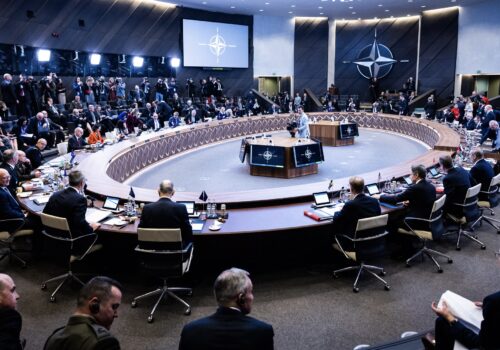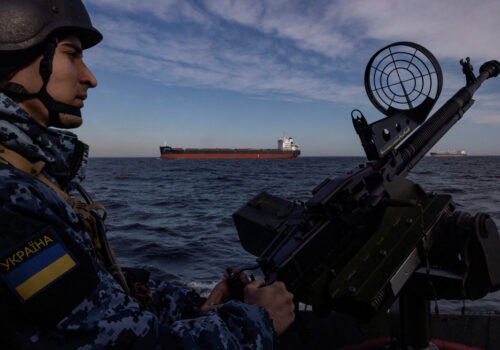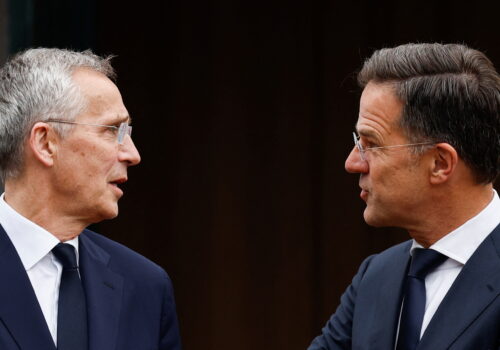NATO should establish a Baltic Security Initiative at the Washington summit
Russia’s recent battlefield successes in its illegal war against Ukraine have raised the level of concern in NATO’s Baltic nations over a future attack on their territory. Russia may come to view the current relative stalemate—with its control over the Donbas, the southern land bridge, and Crimea—as a type of victory, and eventually, as an impetus for further incursions into countries that were once governed from Moscow. While Russian forces have sustained significant losses in Ukraine, multiple estimates conclude that Russia could reconstitute its ground forces in three to five years, and that its air, cyber, and space capabilities are fully intact, as are the bulk of its naval forces (apart from several notable losses in the Black Sea).
That three-to-five-year window for reconstitution gives NATO time to enhance deterrence—and, if necessary, defense—by taking several critical actions focused on the Baltics. Those actions should be packaged as a new Baltic Security Initiative at the upcoming NATO Summit in Washington, DC.
Regional defense plans
First, NATO should announce each member state’s areas of responsibility under the Alliance’s newly developed regional defense plans. NATO has publicly described the new plans and announced that each member state will have certain areas of responsibility. It has not, however, stated publicly which nations will go where. Some of this might be inferred from the leadership and composition of the eight multinational battlegroups that NATO maintains on its eastern frontier from Estonia in the north through Bulgaria in the south. However, those battlegroups, which are generally composed of a brigade headquarters overseeing battalion-sized forces, are more valuable for the strong signals they send than for their actual warfighting capabilities.
Announcing which nations will provide full warfighting capabilities—including ground forces, air defenses, and logistics—would go far toward demonstrating the reality of the new plans to the Baltic nations and to other NATO member publics as well. It would help to deter Russia, and it would underscore the requirement for nations to provide the necessary resources to meet their obligations under the regional plans. As a result, it could encourage greater European defense spending.
Enhanced forward presence
Second, NATO’s enhanced forward presence (EFP) must be strengthened, and NATO should designate European lead nations for each Baltic country. These lead nations will bring both greater forward capabilities and the ability to provide significant reinforcements if required. Germany, which leads the EFP battlegroup in Lithuania, has already taken the first step, announcing in December 2023 that it will place a full-time brigade in Lithuania. Lithuania, meanwhile, will provide host nation support for the brigade, including training areas and family housing. The United Kingdom leads the multinational battlegroup for Estonia, which it provides with a brigade headquarters and battalion-level forces. The United Kingdom should regularly rotate one of its brigades now based in Britain as an ongoing presence in Estonia, with the Estonians providing required host nation support.
Canada has effectively led the multinational battlegroup in Latvia and is planning to increase the amount of its forces to approximately two battalions’ worth. But because of the small size of its military, Canada does not yet have the capability to meet necessary wartime reinforcement requirements. France would be a better choice to deploy a brigade-level EFP force to Latvia. It is true that France already leads the multinational battlegroup in Romania. Romania, however, is less likely to be a land war theater, and France is one of the few nations in NATO that has fully embraced the requirements of high-intensity warfare. With its decision to substantially increase its defense budget, France has the capacity to lead forces in two areas.
To complement European efforts to move the EFP in the region to the full brigade level, the United States should deploy more forward forces. A useful step in this direction was taken in December, when the United States and the Baltic states signed bilateral Roadmaps for Defense Cooperation, in which the United States agreed to “provide heel-to-toe persistent rotational presence of US forces in each Baltic State.” The United States already deploys armor and artillery in Lithuania on a persistent basis. Now, the United States must vigorously implement this pledge, including by deploying brigades in each country, complemented by air defense and longer-range fires.
Third, NATO needs to fully implement the decision at the 2023 Vilnius summit to move from the Baltic Air Policing mission’s relatively limited force of a dozen aircraft to an enhanced Baltic Air and Missile Defense mission with larger numbers of aircraft supported by ground-based air and missile defense. Recent NATO pledges to provide greater rotational air defenses for the region, in addition to Finnish and Swedish membership, provide the capabilities to undertake this transition. The war in Ukraine underlines the importance of having such capabilities in place as quickly as possible.
Enhancing mobility
Fourth, NATO needs to improve its ability to move large numbers of forces quickly. The NATO force model provides that NATO will have one hundred thousand highly ready forces within ten days and two hundred thousand in ten to thirty days. The key, of course, is placing those highly ready forces where they are needed. Local forces, of course, count toward meeting this requirement, as do forces in place on a persistent basis. While the force model is not clear on this point, air forces are presumably also counted. Nonetheless, even with all the current and planned forces described above for the Baltics, NATO would need significant mobility efforts to meet the numbers and speed called for by the force model. The current European Union mobility initiative seems to be losing steam, and NATO needs to do more.
To accelerate enhanced mobility, NATO’s Joint Support and Enabling Command (JSEC) supports NATO’s supreme allied commander in effectuating the Alliance’s mobility. JSEC should work with each nation focused on defense of the Baltics to ensure that they can meet their obligations under the regional plans. The ongoing Steadfast Defender exercise, for example, can provide useful lessons for the practical considerations of moving forces, including the crucial roles for rail and trucks. However, NATO should additionally evaluate whether Norway’s merchant marine fleet, which includes more than one hundred roll-on, roll-off ships, might also be engaged to move forces. The capability of Norway’s fleet, which would be additional to the more limited numbers provided through NATO’s Multinational Sealift Steering Committee, could be important for US and Canadian forces moving from North America, for French and UK forces moving to the Baltics, and even for ground forces from Finland and Sweden moving across the Baltic Sea to Estonia or Latvia.
Revising command and control
Finally, NATO needs to revise its command and control for effective warfighting against a Russian attack. The current command structures below the supreme allied commander Europe (SACEUR) were designed to support a forty-thousand-person force focused on out-of-area operations. Neither Joint Force Command in Brunssum, Netherlands and Naples, Italy, nor any of the subordinate headquarters are organized for the all-out fight necessary against a Russian attack. For that reason, NATO should establish multidomain headquarters that can meet the warfighting requirements of the regional plans for the northeast (the Baltics and Poland), southeast (the Black Sea), the Mediterranean, north and northwest (the United Kingdom, the North Sea, Norway), and the Atlantic. At the Washington summit, the SACEUR should be tasked to provide such an updated structure, which will have to come to grips with important issues such as command over and on the Baltic Sea.
For the Baltics and Poland, however, it should be clear that the lead command nation needs to be the United States. Washington will be providing the bulk of the ground and air capabilities, as well as key enablers including air defense, cyber, space, and multidomain communications. Announcing the requirement for a new command structure and making clear the role that the United States will play in the northeast at the Washington summit would be valuable steps toward enhancing deterrence for the Baltics.
Russia’s illegal invasion of Ukraine underscores its willingness to use force as a method to achieve its geopolitical aims. The Baltic nations are justifiably concerned that they could be the next targets of a reconstituted Russian military. NATO can, however, at its Washington summit, significantly increase its deterrent and defense posture by visibly taking steps to provide effective forces in and for the Baltics.
Franklin D. Kramer is a distinguished fellow and board director at the Atlantic Council and a former assistant secretary of defense for international security affairs.
Hans Binnendijk is a distinguished fellow at the Atlantic Council. He is a former National Security Council senior director for defense policy and vice president of the National Defense University.
Further reading
Tue, Mar 12, 2024
NATO’s decision process has an Achilles’ heel
New Atlanticist By
The Washington Summit in July should address the problem before a crisis exposes this vulnerability.
Mon, Mar 11, 2024
Why Washington’s approach to Black Sea security may be about to change—for the better
TURKEYSource By Arnold C. Dupuy
The NDAA signals a wider shift in Washington's strategy towards the critical Black Sea region and cooperation with littoral partners.
Thu, Mar 7, 2024
What kind of leader is required for the future of the NATO Alliance?
New Atlanticist By Timo S. Koster
Dutch Prime Minister Mark Rutte is the clear front-runner to be the next secretary general, but his candidacy is not quite assured.
Image: Bundeswehr soldiers stand next to a Luftwaffe Eurofighter during the ceremony to mark the takeover of the NATO air policing mission. The Bundeswehr is once again taking over air policing on NATO's eastern flank and will monitor the airspace over Estonia, Latvia and Lithuania until the end of November. For the first time, the air force will be stationed at the Lielvarde military airfield in Latvia.


